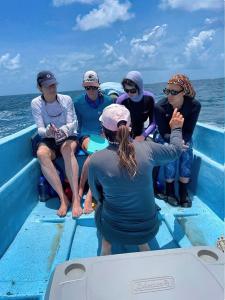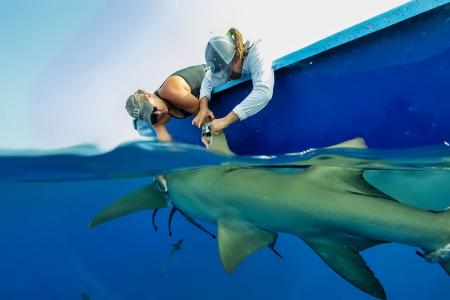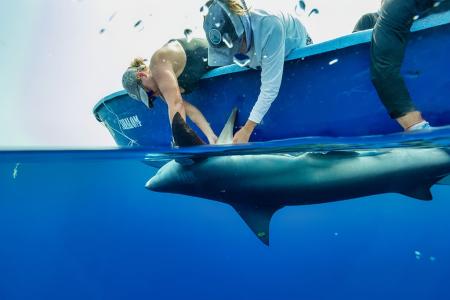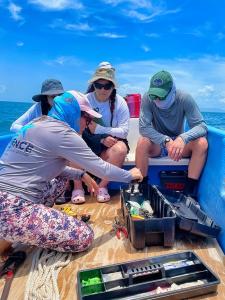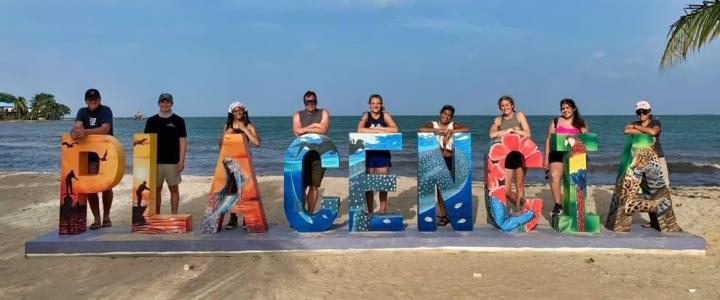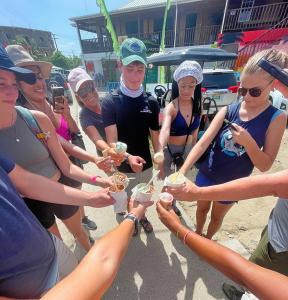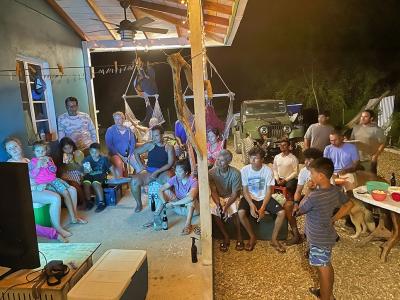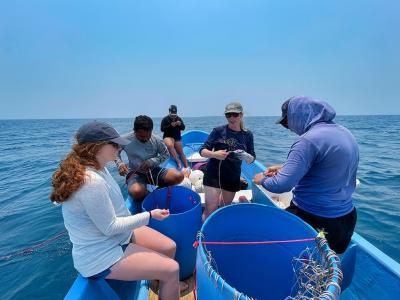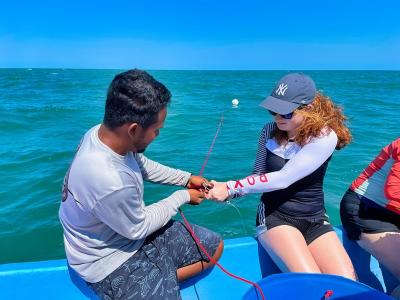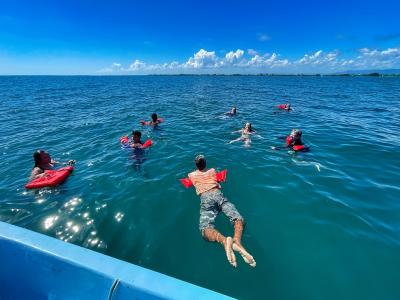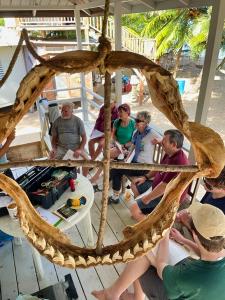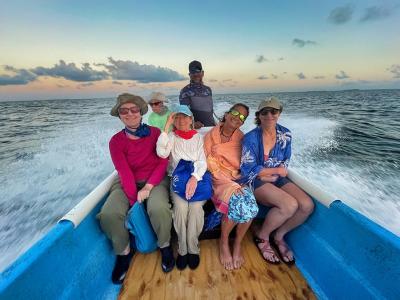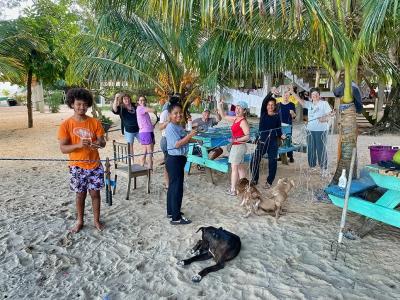.
Please read the following information before leaving for your expedition.
It provides the most accurate information available and will likely answer any questions you have about the project. You may also reach out to your Program Coordinator with any questions you may have.
Click on the images to view full size!
.
COVID-19 Safety
Please test for COVID-19 before traveling to your expedition; do not travel if you have tested positive, and call Earthwatch right away for the next steps. Visit earthwatch.org/covid-19 for more information on how you can help reduce the risk of COVID-19 impacting your expedition.
The Research
Threats to cartilaginous fishes (sharks and rays) are exacerbated in the tropics because there are few data and often less management than in higher latitude high-income nations, coupled with intensive fishing and a greater reliance on fishing for food and livelihood security (Dulvy et al. 2014). Belize is a rare example of a tropical nation actively managing its shark fishery for sustainability. Species that live along the coast and main reef are subject to seasonal fishing by a small number (~ 40) of licensed fishers, with longlines being the only permitted gear since gillnets were prohibited in 2020. Species in the fishery commonly taken inside the main reef and along the coast include blacktip (Carcharhinus limbatus), sharpnose (Rhizoprionodon porosus), shovelbill (Sphyrna aff. tiburo), scalloped hammerhead (Sphyrna lewini), great hammerhead (Sphyrna mokarran), lemon (Negaprion brevirostris), and bull (Carcharhinus leucas) sharks (Quinlan et al. 2021). Salted meat and dried fins from all of these species are exported to Guatemala for consumption during the Lenten season or for export to southeast Asia (Quinlan et al. 2021).
Most shark research and monitoring in Belize has focused on offshore atolls, where sharks are more abundant, and shark fishing has been prohibited since 2021 (Clementi et al. 2021). Most shark fishing occurs from the coast to the main reef, and shark species diversity is likely higher in these habitats than in the atolls. Moving forward, to assess the status of sharks and the shark fishery in Belize, monitoring species’ relative abundance and diversity over time within the fishing grounds will be necessary. Moreover, to interpret trends, it is imperative to understand the residency, movements, and habitat use of each species. This information will be central for managing the fishery, especially since Belize has international obligations under the Convention on International Trade of Endangered Species (CITES) to ensure that international trade of these species is legal, transparent, and sustainable.
Research Aims
The overarching aim of the research is to further our understanding of the biology and ecology of key shark species in Belize with the goal of informing fisheries management and conservation. The objectives of this project are to (1) understand coastal shark population trends over time in fished habitats from the main reef to the coast, (2) understand residency times, habitat use, and movements of coastal shark species in these areas and around the Gladden Spit and Silk Cayes Marine Reserve [GSSCMR]) and connectivity between the barrier reef and atolls, (3) collect life history data to improve length-based assessments of key species in the shark fishery, and (4) continue to collaboratively work with shark fishers to obtain this information and contribute to a shared understanding of the status of the sharks and shark fishery.
Objective 1: Understand coastal shark population trends over time in fished habitats from the main reef to the coast (the main activity volunteers will be helping with every time they are here)
Currently, the only measure of relative abundance for coastal sharks in Belize is taken directly from the fishery (fishery-dependent data). This is done primarily through the Anal Fin Monitoring Program (AFMP). In short, licensed shark fishers are required to remove and submit the anal fin from every shark they land to Belize Fisheries Department (BFD). The anal fins are visually identified to determine which species of shark each fin came from, and the length of the animal the fin came from is determined using a species-specific regression equation (Quinlan et al. 2021). This has been incredibly important to help researchers and managers monitor shark landings and conduct assessments to detect any alarming trends (e.g., retention of only immature individuals).
Nevertheless, it is also important to collect fisheries-independent data: data not collected from the fishery. We do this by conducting a standardized survey: in our case, a coastal longline survey. Fishers aim to maximize their catch and will adjust their fishing methods (i.e., where they fish, what gear they use, how they set their gear, how long they fish, etc.) to improve their chances of catching sharks. A standardized longline survey is uniformly deployed each time using the same method (i.e., time left in the water, number of hooks, where it is deployed, etc.) In doing this, if we detect an increase or decrease in the number of sharks caught, we can report with confidence that the shift we are seeing is likely a change in the relative abundance of that species and not due to a shift in fishing effort (e.g., more hooks, or longer time spent fishing). The coastal longline survey will serve as a baseline for the relative abundance of coastal shark species in Belize, and its initiation comes at the perfect time, as a recent ban on gillnets will likely affect the relative abundance of coastal shark species.
Objective 2: Understand residency times, habitat use, and movements of coastal shark species in these areas and around the Gladden Spit and Silk Cayes Marine Reserve [GSSCMR]) and connectivity between the barrier reef and atolls.
Acoustic telemetry will be used to better understand movements by fitting targeted shark species with acoustic transmitters that can be detected by acoustic receivers we have deployed on the seafloor. Simply put, the tag placed in the shark has a unique acoustic signature that can be detected by the receivers that record the tag’s unique identifier. The data collected on the receivers are downloaded to determine which sharks were detected in the area and for how long. Ultimately, we aim to deploy an array of receivers within our survey sites and GSSCMR to enable us to track the movements of tagged sharks over a larger area. Volunteers will help catch targeted species during the day to tag individuals acoustically. This sampling site is outside the main reef, and accessing it depends highly on the weather.
Objective 3: Collect life history data to improve length-based assessments of key species in the shark fishery.
The Anal Fin Monitoring Program (AFMP) has enabled Belize to collect the fundamental data needed to monitor shark landings: what species are being landed, how many of each, and at what lengths. The resulting length data have been analyzed through length-based assessments (Quinlan & Chapman, unpublished report) to track size trends and changes in what proportions of the landings are within different sustainability indicator categories ( e.g., the proportion of the catch that is mature). Unfortunately, life history data, such as length at maturity, is lacking in this region for many sharks. Thus, the length-based analyses had to source this from the nearest locations (often outside the Mesoamerican region). This is potentially problematic as length at maturity has high geographic variability (Lombardi-Carlson et al. 2003) and is possibly influenced by density-dependent factors (Carlson & Baremore 2003). Therefore, locally relevant maturity data are needed in Belize to conduct accurate length-based assessments that underpin effective fisheries management and sustainable yields. During the shark fishing season (November–April), we will visit shark fishing camps to access dead specimens (maturity for females can only be determined internally) of key species within the fishery to obtain accurate length at maturity, as well as collect vertebrae samples to be analyzed by experts to determine age at maturity. Fishers fish at random times, and there is no guarantee fish camps will be active while volunteers are here. Still, any group that books during the shark fishing season has a high likelihood of getting to visit a landing site to collect these data.
Objective 4: Continue to collaboratively work with shark fishers to obtain this information and contribute to a shared understanding of the status of the sharks and shark fishery.
The working relationship between fisherfolk and researchers here in Riversdale started in 2019 when Dr. Chapman and Dr. Quinlan initiated and facilitated a collaboration with fisherfolk to assist researchers with their scientific research. The goal was to reduce fishing pressure and, thus, shark landings by hiring fisherfolk throughout the shark fishing season to do science rather than fish. This massive success resulted in a nearly 50% reduction in shark landings in the first year. It has also created a pathway for researchers and fishers to exchange knowledge while increasing our collective understanding of sharks in Belize. It has increased fisherfolk's presence in scientific research and resource management.
How You Will Help
Time-series data are incredibly powerful datasets. They allow us to track trends over time and provide robust, reliable data that can inform management. Regardless of their benefits, finding consistent funding and personnel to conduct these long-term surveys can be difficult. Earthwatch has played an integral role in helping our team measure the relative abundance of sharks around a remote atoll using Baited Remote Underwater Surveys (BRUVs). This dataset detected a steep decline in the relative abundance of Caribbean reef sharks in time for managers to act. It contributed to the regulations created to safeguard these species in this area. Through continued monitoring in this way, we can thankfully say this regulation has had the intended effect, and the relative abundance of Caribbean reef sharks at the atoll is increasing (Chapman, unpublished report). Now, Earthwatch will assist with fishing surveys to collect a baseline of relative abundance for coastal species. This survey will monitor trends over time and inform resource managers while consistently providing an outlet to diversify fisher’s income.
Life in the Field
Weather and research needs can lead to changes in the daily schedule. We appreciate your cooperation and understanding.
A typical workday will consist of breakfast in the morning, a daytime activity such as cleaning the village park, walking to a nearby creek to spot crocodiles, swimming, or relaxing. We will have lunch on land, after which we will begin preparations for nighttime fishing. Prep includes preparing your personal gear, packing up fishing gear left out to dry, cutting up bait for the fishing lines, repairing any damaged gear, and loading the boats. When fishing, volunteers will work in two groups, each on one boat. Each team will deploy a standardized longline, check their line, and work up any sharks caught on their line. Longlines are typically set approximately an hour before the sun sets. Depending on our fishing site, dinner will either be packed to carry on the boat or prepared for us to have on the beach while our longlines are deployed. Both lines are checked after 2 hours and hauled after an additional 2 hours. Upon return to the beach, teams will offload all gear, rinse, dry, and grease equipment so it dries overnight. Rinse. Sleep. Repeat. Weather permitting, we will fish outside the barrier reef on our best weather day, where there will be an opportunity to snorkel and learn a different fishing method to target larger sharks that frequent a known spawning aggregation site.
ITINERARY
Weather and research needs can lead to changes in the daily schedule. We appreciate your cooperation and understanding.
- DAY 1: Rendezvous at Placencia Airport/ meet your team, introduction to Riversdale and accommodations
- DAYS 2–4: Introduction to research and training day
- DAYS: 3–6: Deploy coastal longline survey (fishing for sharks)
- DAY 7: Recreational day
- DAY: 8: Early morning departure from Riversdale to Placencia Airport
Accommodations and Food
* Please note that not every expedition has couples’ or singles' accommodations available. Please call or email Earthwatch to check availability before reserving your space(s) on the team.
SLEEPING
Accommodations are two modest beachfront houses located on the properties of fisherfolk with whom we work. Volunteers are divided by gender, and sleeping quarters are shared spaces with bunk beds, each equipped with an electric fan. We are unable to accommodate shared room requests for people of different genders.
Please note that room selection is determined by the field station and rental house availability and is not up to Earthwatch or the field staff.
* Earthwatch will honor each person’s assertion of gender identity respectfully and without judgment. For both teen and adult teams, where logistics dictate single-sex accommodations or other facilities, participant placements will be made in accordance with the gender identity the participant specified on their Earthwatch Participant form and/or preferences indicated in discussions with Earthwatch.
BATHROOMS
Bathrooms (shower, sink, and toilet) may be located within each house or as detached facilities, depending on which property we rent. Showers, sinks, and toilets are fed by captured freshwater during the rainy season and for most of the year, and as we live off rainwater, there are no hot showers.
ELECTRICITY
In Belize, the standard voltage is 110/220 V. The standard frequency is 60 Hz. The power sockets used are of type B / G. Please note that electricity in Belize can be interrupted by weather conditions. All rooms have 24-hour electricity, electrical sockets, and an electric fan. 110/ 220 (Type B sockets).
PERSONAL COMMUNICATIONS
Wireless Internet is available at the dorms. Outages are common.
Please note: Earthwatch encourages volunteers to minimize outgoing calls and immerse themselves in the experience; likewise, family and friends should restrict calls to urgent messages only. Emergency communications will be prioritized.
DISTANCE TO THE FIELD SITE
Variable, but usually 1–20 kilometers (0.6–6 miles). You’ll be transported to and from the field in a small boat.
FOOD AND WATER
Three meals per day will be provided; packed meals will be provided for mealtimes when we are on the water. The food is prepared by a local woman within the fishing village and will be local Belizean cuisine.
The following are examples of foods you may find in the field. Variety depends on availability. We appreciate your flexibility.
TYPICAL MEALS
- Breakfast: Bread or something similar (fried jacks, journey cake or johnny cake, cornbread, pancakes) with meat (ham, sausage, bacon) and a selection of fruit
- Lunch: Pasta, chicken, pizza, fish, stewed beef or chicken with beans and rice, salad, or cooked vegetables on the side, peanut butter & jelly, dessert
- Dinner: Similar options as lunch
- Beverages: Water, tea, and coffee are available to drink. Lunch and dinner are usually served with fresh juice. Safe drinking water is always available.
SPECIAL DIETARY REQUIREMENTS
Please alert Earthwatch to any special dietary requirements (e.g., diabetes, lactose intolerance, nut, seafood, other food allergies, vegetarian, or vegan diets) as soon as possible and note them in the space on your volunteer forms.
SPECIAL NOTE TO VEGETARIANS: Fresh fruits and vegetables can be difficult to find at times, which typically results in a starchier diet for a vegetarian (rice, potatoes, yucca, kasava etc.) If this is an issue, then participation on this Earthwatch expedition should be seriously reconsidered.
SPECIAL NOTE TO VEGANS: Please be aware that we are unable to accommodate strict vegans. It may be possible to get meatless meals, but vegans will be unable to avoid animal products altogether. If this is an issue, then participation on this Earthwatch expedition should be seriously reconsidered.
Project Conditions
The following information is as accurate as possible, but please remember that conditions may change.
GENERAL CONDITIONS
Please visit wunderground.com and search your project location for weather and region-specific information.
BOATING CONDITIONS
We work from an open 20- to 25-foot fiberglass research vessel. There is no bathroom on board, but we can take bathroom breaks during the workday on nearby islands, in the water, or directly off the boat.
The boat has no canopy or shade, so shirts, brimmed hats, neck gaiters (or light scarves), and consistently reapplied sunscreen are essential.
The vessel has seats and safety equipment. We plan our research accordingly and will adjust work plans so the volunteers are comfortable with the sea conditions.
We load equipment on and off the boat (which involves lifting 20- 40-pound crates (between 2 people)). You may assist or opt out of this activity.
Essential Eligibility Requirements
All participants must be able to:
- Wear all protective equipment recommended or required by industry standards.
- Work on a boat for approximately 6-8 hours per day with limited break options (e.g., there is no bathroom on the boat, except for the ocean or the islands where we will stop)
- Maintain a seated, upright position within the boat during transit, which can sometimes be bumpy. This can be uncomfortable for individuals with back problems.
- Enjoy being outdoors all day in all types of weather and the potential presence of wild animals and insects.
- Endure tropic (hot and humid) work conditions.
- Be comfortable with living in and moving between remote study sites.
- Follow verbal and/or visual instructions independently or with the assistance of a companion.
- Take an active role in one’s safety by recognizing and avoiding hazards if and when they arise (including, but not limited to, those described in Earthwatch materials and safety briefings). Always comply with project staff instructions and recommended safety measures.
- Effectively communicate to the staff if they experience distress or need assistance.
- Get along with a variety of people from different backgrounds, often in close proximity, for the duration of the team.
- Be comfortable being surrounded by a language and/or culture that is not your own.
Health and Safety
EMERGENCIES IN THE FIELD
Project staff members are not medical professionals.
Earthwatch has a 24-hour, 7-day-a-week emergency hotline number. Someone is always on call to respond to messages that come into our live answering service.
IMMUNIZATIONS & TRAVEL VACCINATIONS
Please be sure your routine immunizations are up to date (for example, diphtheria, pertussis, tetanus, polio, measles, mumps, rubella, and varicella) and that you have the appropriate vaccinations for your travel destination. Medical decisions are the responsibility of each volunteer and their doctor. Visit the Center for Disease Control and Prevention or the World Health Organization for guidance on immunizations.
If traveling from countries or regions where yellow fever is endemic, you must have a certificate of vaccination.
Staying up to date with your COVID-19 vaccinations, including receiving booster doses, as applicable, is strongly encouraged.
Project Risks and Precautions
HIKING/WALKING
There is minimal danger given the terrain of the accommodations and coastal beach area. Walking paths are flat dirt roads, and tough sandals that strap onto your feet are recommended (e.g., Tevas or Chacos). The hike in Cockscomb Wildlife Sanctuary is also on well-maintained paths, but due to the incline, it's recommended to wear a sneaker or hiking boots for better grip while hiking and to avoid stubbing toes and minor cuts and scrapes.
INSECTS
Sand flies (also known as “sand fleas” or “no-see-ums”) and mosquitoes are nuisances throughout the year. Sand flies are believed to be a vector for leishmaniasis in some regions. Some find them only irritating, but people occasionally react badly to the bites. Please come prepared with an oral antihistamine you know you can tolerate and a topical anti-itch cream. Those traveling from outside the Americas may react more severely to bites. To avoid sand flies, use baby oil or wear lightweight, long pants and socks in the evening (they generally bite from the knees down). Mosquitoes may transmit several diseases, including malaria and Zika virus, which are present in Belize (see the Safety section for more information). Repellents containing DEET work well against mosquitoes. Wear lightweight, long pants, shirts, and socks in the evening to avoid them.
MARINE ANIMALS/ PLANTS
Working with sharks alongside or in a boat is inherently dangerous. All sharks we work with are hooked in the mouth and are secured before the workup. Teams will be heavily supervised during this activity and will not touch sharks forward of their dorsal fins. The staff members have years of experience working without incident with sharks.
Potentially dangerous animals encountered while snorkeling include sharks, stingrays, sea urchins, lionfish, and jellyfish. Although rare, saltwater crocodiles have been seen. Staff will train you to identify dangerous species and avoid touching organisms. Those with a severe allergy to bee or wasp stings may have a similarly dangerous reaction to corals and jellyfish. They must always carry an EpiPen and notify staff of its location.
CLIMATE/WEATHER
The Caribbean sun is very intense. Please bring plenty of good-quality waterproof sunscreen at several SPF levels. You will also want to bring after-sun lotion to soothe your skin after a long day in the sun. Some volunteers have found it helpful to bring long-sleeved, lightweight, quick-drying shirts and long pants to wear when not in the water (including on the boat between snorkels). A hat with a wide brim and a neck gaiter or loose scarf are recommended, as are polarized sunglasses and a chord to secure them around your neck. With the sun comes heat and risks of overheating and dehydration. Both can lead to illness. Drinking water frequently and minimizing exposure to the sun will help make your experience more enjoyable. During the field season, brief periods of intense rain are not uncommon, so a sturdy rain jacket is mandatory. More extreme tropical storms and hurricanes traditionally occur from June through November, with late August, September, and October being the most active periods. A hurricane plan exists and will be followed in the case of an extreme weather event. Because of the high humidity, people who use a hearing aid may find it doesn’t work properly. Consider purchasing a hearing aid dehumidifier.
For teams arriving in January, warmer clothing is necessary. Volunteers will be reminded each day about appropriate clothing requirements. Field activities will cease in extremely windy/stormy weather until the weather improves.
PROJECT TASKS/ EQUIPMENT
We will work with some sharp items (hooks) and bait (spines). Volunteers will be issued gloves and will be trained in the safe handling of these items.
WORKING ON A BOAT
Working aboard a small boat poses a risk. Bouncing or jostling can be quite uncomfortable for volunteers with chronic back problems or a history of seasickness. Boat surfaces are wet and can be slippery, putting one at risk of falling and injury. You must be able to keep your balance on a rocking boat. Unplanned immersion in the water from falling overboard can also put one at risk of injury and/or cold-related illnesses. The boats are equipped with appropriate safety equipment, including life jackets for each person. Volunteers will be trained on how to move around the boat safely. Sensible footwear (water-friendly shoes or sandals) can be worn on the boat, but not flip-flops.
SWIMMING
Swimming may be possible during recreational time, and typical water-related risks, such as strong currents, jellyfish, etc., will be present. A certified lifeguard is unlikely to be available. A provided dive flag is required to be displayed from the dock or floated behind you.
SNORKELING
There are inherent risks to snorkeling, including the effects of environmental conditions, nitrogen (for those who’ve recently been scuba diving), barotrauma, boat traffic, marine life, and other risks specific to your physical/medical history. When snorkeling, it is important to learn to control your breathing properly to reduce the risk of hyperventilation and blackout. You need to bring and maintain your own mask, snorkel, fins, booties, and exposure protection (e.g., rash guard). Snorkel vests can be provided for those who either prefer them or are required to use them. It is critical that you ensure that all gear is in good working order and that you are fully trained in appropriate response if a failure occurs while in the water. All snorkeling will be optional and must be done in designated areas approved by staff; snorkelers should understand there is no lifeguard on duty. They should also practice the buddy system and take a dive float out with them. Typical in-water hazards include fire coral, sea urchins, jellyfish, occasional boat traffic, strong currents, dangerous bottom conditions (drop-off, mud), biting, or territorial animals.
You are required to bring your snorkeling gear (mask, snorkel, and fins) if you choose to participate. Please check your gear for functionality before your arrival, as there are no dive shops at the field stations. Avoid bringing short swim fins; proper snorkeling fins are essential.
DISTANCE FROM MEDICAL CARE
The nearest hospital is 22–35 kilometers (13–21 miles) away from the project site by boat (depending on base location), and it may take up to two hours to arrange transport and reach the hospital. If you have a chronic condition that could require immediate medical care (e.g., heart conditions, kidney problems, severe asthma, etc.), or if you are pregnant, please discuss your participation on this expedition with your physician.
COVID-19 DISEASE RISKS
COVID-19 remains an evolving risk to communities and individuals around the world.
Earthwatch strongly encourages you to stay up to date with your vaccinations, including receiving booster doses if available and to continue to take steps to limit your exposure before your program, such as wearing a mask during travel and frequently washing your hands. Persons with a higher risk of severe illness from COVID-19 should consult with their healthcare provider before participation.
If you, or another person on site, display symptoms of illness or test positive for COVID-19, you may be required to wear a mask, test for COVID-19, seek medical advice, isolate/quarantine on- or off-site, cease or limit participation in program activities, and/or take other precautions. If local conditions or recommendations from authorities change, additional requirements may be implemented.
If you must isolate or depart from a program due to COVID-19 or other illness, you will not be entitled to a refund of the contribution for the program, nor any expenses resulting from your participation in the program or a disruption of your travel plans. We strongly encourage you to purchase travel insurance that will cover this eventuality.
Travel Planning
Placencia Airport, Belize (Airport code: PLJ)
Specific travel planning details will be provided in your Earthwatch Expedition Logistics Document. This document can be found in your MyEarthwatch Portal once you enroll. Please do not book travel arrangements—such as flights—until the Expedition Logistics Document matching the current year has been published to your portal account.
ABOUT YOUR DESTINATION
Earthwatch strongly recommends that travelers investigate their destination before departure. Familiarity with the destination’s entry/exit requirements, visas, local laws, and customs can ensure smooth travel. The U.S. Department of State's Traveler’s Checklist and Destination Guides are helpful resources. For LGBTI travelers, the U.S. Department of State's LGBTI Travelers page contains many helpful tips and links.
COUNTRY AND PROJECT ENTRY REQUIREMENTS
You are responsible for reviewing and abiding by your destination's entry/exit requirements.
Entry visa requirements differ by country of origin, layover, and destination and do change unexpectedly. For this reason, please confirm your visa requirements at the time of booking and again 90 days before travel. Please apply early for your visa (we recommend starting six months before the start of your expedition). Refunds will not be made for volunteers canceling due to not obtaining their visa in time to meet the team at the rendezvous. You can find up-to-date visa requirements at travisa.com.
If a visa is required, participants should apply for a TOURIST visa. Please note that obtaining a visa can take weeks or even months. We strongly recommend using a visa agency to expedite and simplify the process.
Generally, passports must be valid for at least six months from the date of entry, and a return ticket is required.
Resources
PROJECT-RELATED MEDIA
- Fishers4Science
- Sharks in Belize: Jaguars of the Sea | Changing Seas
- Global FinPrint
- Predator Ecology and Conservation Lab
ARTICLES
- Bond ME, Valentin-Albanese J, Babcock EA, Abercrombie D, Lamb NF, Miranda A, Pikitch EK, Chapman DD. 2017. “Abundance and size structure of a reef shark population within a marine reserve has remained stable for over a decade.” Marine Ecology Progress Series, 576: 1-10.
- Bernard AM, Horn RL, Chapman DD, Feldheim KA, Garla RC, Brooks EJ, Gore MA, Shivji MS. 2017. “Genetic connectivity of a coral reef ecosystem predator: the population genetic structure and evolutionary history of the Caribbean reef shark (Carcharhinus perezi).” Journal of Biogeography.
- Fields AT, Feldheim KA, Gelsleichter J, Pfoertner C, Chapman DD. 2016. “Population structure and cryptic speciation in bonnethead sharks Sphyrna tiburo in the southeastern USA and Caribbean.” Journal of Fish Biology 89 (5): 2219-2233.
- Bond ME, Babcock EA, Pikitch EK, Abercrombie DL, Lamb NF, Chapman DD. “Reef Sharks Exhibit Site-Fidelity and Higher Relative Abundance in Marine Reserves on the Mesoamerican Barrier Reef.” PLoS ONE 7(3): e32983.
BOOKS
- Sobel, Jack and Craig Dahlgren. Marine Reserves: A Guide to Science, Design, and Use. Island Press: 2004.
FIELD GUIDES
- Humann, Paul and Ned DeLoach. Reef Fish Identification Florida Caribbean Bahamas (3rd ed). New World Publications: 2002.
LITERATURE CITED
- Bond, M. E., Babcock, E. A., Pikitch, E. K., Abercrombie, D. L., Lamb, N. F., Chapman, D. D. (2012). Reef sharks exhibit site fidelity and higher relative abundance in marine reserves on the Mesoamerican Barrier Reef. PloS one 7(3), e32983.
- Clementi, G. M., et al. (2021). Anthropogenic pressures on reef-associated sharks in jurisdictions with and without directed shark fishing. Marine Ecology Progress Series, 661, 175-186.
- Dulvy, N. K., et al. (2014). Extinction risk and conservation of the world’s sharks and rays. elife, 3, e00590.Dent, F., Clarke, S. (2015). State of the global market for shark products. FAO Fisheries and Aquaculture Technical Paper 590, I.
- Quinlan, J. R., O'Leary, S. J., Fields, A. T., Benavides, M., Stumpf, E., Carcamo, R., ... & Chapman, D. D. (2021). Using fisher‐contributed secondary fins to fill critical shark‐fisheries data gaps. Conservation Biology, 35(3), 991-1001.
- Simpfendorfer, C. A., & Dulvy, N. K. (2017). Bright spots of sustainable shark fishing. Curr. Biol. 27(3), R97-R98.
- Zeller, D., Graham, R., Harper, S. (2011). Reconstruction of total marine fisheries catches for Belize, 1950-2008. In: M. L. D. Palomares & D. Pauly, eds. Too Precious to Drill: the Marine Biodiversity of Belize. Fisheries Centre Research Reports 19(6), 142-151. Fisheries Centre, University of British Columbia [ISSN 1198-6727].
Sign up for the Earthwatch Newsletter
Be the first to know about new expeditions, stories from the field, and exciting Earthwatch news.
.
.
.
